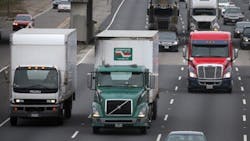Hot Lanes, Fast Lanes and E-ZPass have entered our lexicon as toll roads are created and are piggybacked onto existing highways in major metropolitan areas. But as tolling becomes a more popular method for financing roads, bridges and tunnels, the question ultimately arises – where does all that money go?
The American Transportation Research Institute says it has found an answer and released a new study supporting its long-held view that diversion of funds to things like mass transit make tolling the least efficient and most unfair method for financing infrastructure projects.
“It is clear from this research that highway funding mechanisms that return our tax investments to highways are far superior to tolling,” commented ATRI board member Darren Hawkins, who also is chief executive officer of YRC Worldwide. “We need greater oversight and transparency to ensure that the billions of dollars paid by our industry goes back into the roads and bridges that generate the revenue.”
The report explains that user fees such as motor fuels taxes are the traditional tools for equitably funding the 4.1 million miles of U.S. roadway – including the critical 220,000 miles of National Highway System. The 2017 federal Highway Trust Fund Highway Account revenues of approximately $35 billion were collected through taxes paid by U.S. drivers across the myriad roadways used by motorists.
Toll facility operators, on the other hand, control less than 6,000 miles of roadway (the equivalent of 2.6% of the National Highway System) while collecting an estimated $18 billion in annual revenue.
In addition, toll revenue increased more than 72% over the last decade compared to the growth of inflation, which came in at just 16.9%, ATRI points out. The study documents the recent collection and distribution of $14.7 billion in toll revenue, representing 82% of all U.S. toll collections.
ATRI, which is the nonprofit research arm of American Trucking Associations, also conducted two previous studies of tolling. A 2007 report cited toll collection costs of 21.9% to 30.3% of revenue that occurred in the early 2000s – contrasted with federal fuel tax administrative costs of 0.2% of total revenue. A 2017 study by ATRI concluded that tolling was the least effective method for funding a national system of highways when compared to five other sources of funding.
ATRI’s most recent study finds that for the 21 major toll systems it selected for analysis, more than $14.7 billion in revenue was collected, but nearly 50% was diverted to uses other than construction and maintenance. This excess revenue is diverted in a number of ways, depending on how the individual agency that supervises the toll entity operates.
Lack of Control and Standards
“The magnitude of diversion and the lack of standard practice with regard to revenue diversion speaks to the disjointed control under which toll entities operate,” ATRI observes. This is in stark contrast to the supervision and public policy standards that dominate the use of federal fuel tax revenue and the supervision of the expenditures of these resources by agencies such as the Federal Highway Administration.
ATRI cites the Pennsylvania Turnpike as a prime example of this disfunction. State legislators in 2007 directed the Turnpike to supply $450 million annually for to be spent on highways, bridges and public transit. Then in 2013 the legislature redirected that full $450 million in revenue to go to mass transit alone. Because of this, the commission says it was forced to raise toll rates for 11 straight years and has driven up the agency’s debt levels to more than $11 billion, and caused it to suggest that the turnpike “needs to provide relief to its customers.”
One result of tolling is that truckers, many of whom are engaged in interstate commerce in primarily rural areas, are burdened with significantly high toll costs that fund in part urban mass transit projects people who live outside those areas don’t benefit from, ATRI says.
The study also examines several other states that have proposed tolls specifically designed to apply just to truckers. One of these special tolls already applied in Connecticut is being challenged in court for violating the Constitution’s Commerce Clause. However, this has not daunted other states that are actively considering the idea.
“Trucking is often a target revenue source for those states that need money to close funding gaps,” the researchers note. “This is often an easy political decision since truck tolls are charged to businesses, not individuals or voters. Likewise, trucks often have no choice but to pay a toll due to lack of alternative routes.”
One major roadblock to reform is the lack of reliable data available from the various toll authorities. Tt is nearly impossible for toll users to thoroughly analyze where the money is going because the state authorities have chosen not to adhere to generally accepted accounting practices that they are supposed to apply to their activities. The researchers says they had to expend considerable effort to discover methods for unraveling these budgets so they could obtain the data they needed.
“If toll facilities are to be operated as a profit center for the given governmental or private entity, then one must question on what basis the service is priced and what level of profit is appropriate and reasonable as a government monopoly or exclusive provider of a given travel route,” ATRI concludes.
“Toll users, including the trucking industry, are spending billions of dollars annually to access toll facilities. Reporting ‘standards of practice’ that protect the rights and resources of the toll facility users should be in place to ensure funds are invested appropriately into highways. Such standards should include clear and transparent metrics describing facility costs and revenue allocation, as well metrics describing user groups and user behavior.”
About the Author

David Sparkman
founding editor
David Sparkman is founding editor of ACWI Advance (www.acwi.org), the newsletter of the American Chain of Warehouses Inc. He also heads David Sparkman Consulting, a Washington D.C. area public relations and communications firm. Prior to these he was director of industry relations for the International Warehouse Logistics Association. Sparkman has also been a freelance writer, specializing in logistics and freight transportation. He has served as vice president of communications for the American Moving and Storage Association, director of communications for the National Private Truck Council, and for two decades with American Trucking Associations on its weekly newspaper, Transport Topics.
